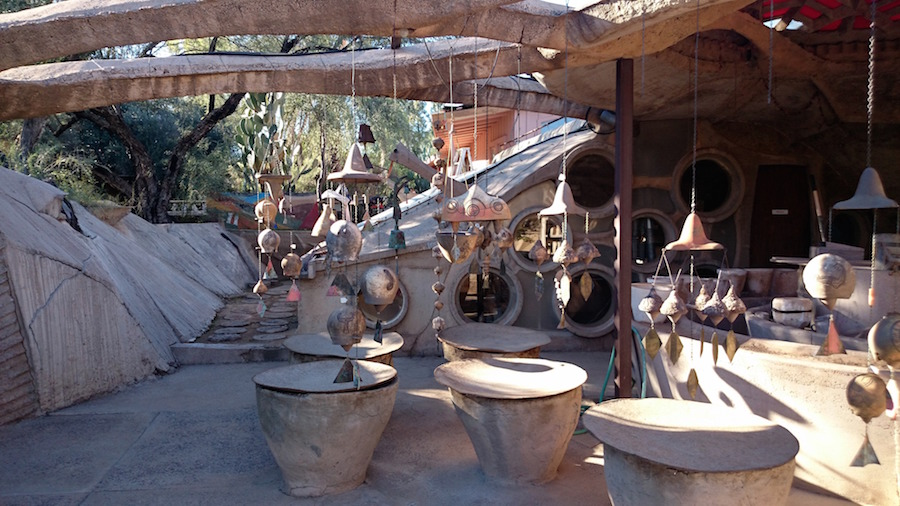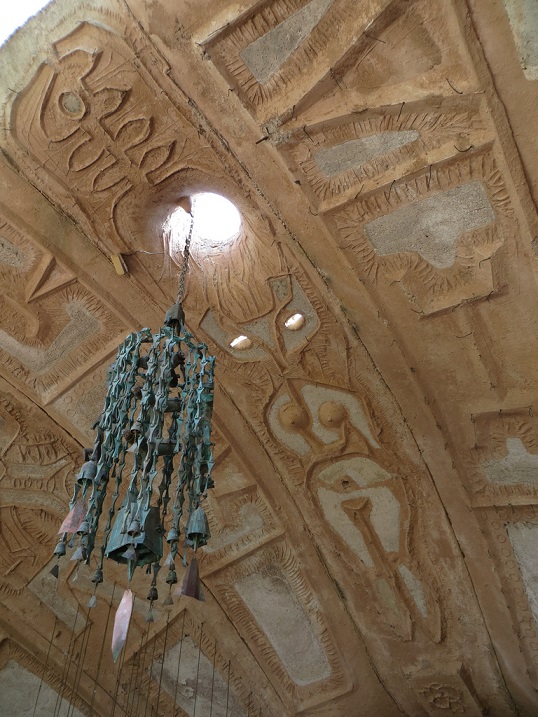
The Bells of Arcosanti: Fifty Years of Ecological Warning
 The Bells of Arcosanti: Sounding Ecological Alarm for Fifty Years
The Bells of Arcosanti: Sounding Ecological Alarm for Fifty Years
Paolo Soleri’s dream of an urban utopia lives on in Arizona. And the bells are still chiming.
Grotesquely beautiful ceramic and brass bells of Arcosanti are the joint creation of Paolo Soleri and his wife, Colly. Sold in malls and over the Internet, the bells of Arcosanti have gradually become familiar fixtures in homes and schools around the world. But if you were thinking these bells were intended purely as trinkets of fashion to accent patios and verandas, you’d be wrong.
This is a work of art armed with a call to arms against the compound problems of an exploding world population, worsening pollution, shrinking resources, and poor public policy. Soleri was alarmed by what he saw in our global environment and the waste of typical urban settings. Many of these signs have only recently been raised, but he has been sounding his warning bells for more than fifty years.
Originating from Turin, Italy, Soleri received a doctorate in architecture, graduating with highest honors from Torino Polytechnico University in 1946. In 1947, he studied under the master architect Frank Lloyd Wright and soon gained world recognition as a seminal designer of bridges and commercial buildings. Then one day he paused to think about what he was contributing to the world.
What he saw was an “unwieldy sprawl for miles.” Commenting in his book Earth’s Answer (1977), he realized that cities are gradually transforming the Earth, “turning farms into parking lots while wasting enormous amounts of time and energy transporting people, goods, and services over their vast expanses.” A typical city, he noted, devotes up to sixty percent of its land for roads and parking lots – and there never seems to be enough of either.
Soleri’s observations crystallized into a revolutionary notion: miniaturize the city to a human scale that enables conservation of land, energy, and other resources; in short, a wholesale reconstruction of the Earth’s cities into ecologically sustainable urban systems. He framed his nonconformist concepts into a new discipline called ‘arcology’: the fusion of architecture, urban design, and ecology.
Paradoxically, arcology promotes the city as a means to save the environment and humankind. However, as our populations grow and the demand for food and energy increases, we must concentrate more of our living space into smaller, easily manageable habitats. Soleri claims that through this form of urbanization, we will not only achieve ecological preservation but human preservation as well.
A journey through urban planning.
He spent 10 years building up a promising architectural career in Italy and went to Scottsdale, Arizona to begin a crusade to save the urban human from its worst enemy – itself. In 1956, he and his wife began searching the arid, open spaces for a place that would help seed their movement. After a few months of searching, they found a little plot of land about 60 miles from Phoenix near a place called Cordes Junction.
Work on the prototype began almost immediately; a city they named Arcosanti. Envisioned for a population of 7,000 people, the project began modestly with an experimental ‘Earth House’. Since then, Soleri, his students, and hundreds of volunteers from around the world have expanded Arcosanti to include various studios, classrooms, housing, and common use areas. According to the official Website, arcosanti.org, the habitat is an ‘urban laboratory’ – an experiment that will ultimately see a compact, complex urban structure with large-scale solar greenhouses occupying 10 acres of a 4,000-acre preserve.
Some critics are not kind to Arcosanti. They point to forty-four years of work with a lackluster 10 percent of the master plan completed as evidence of its failure. After earning the dubious title as an official Arizona tourist site in the late 1970s, one critic proclaimed that Arcosanti looked more like an amusement park as it played host to numerous festivals, conferences, and performances.
Even ardent supporters admit that true arcology – as defined by its creator – remains as elusive as ever. Nevertheless, Soleri’s supporters maintain that the Arcosanti experiment is immensely successful as a teaching laboratory. They also point to the fact that the project has captivated the imaginations of a new breed of architects and urban planners who are willing to challenge established standards and trends.
Since achieving world status with the 1971 landmark book, Arcology: The City in the Image of Man, Arcosanti has become the focal point for students of architecture, urban planning, and design. The city also entertains a wide range of professional disciplines and is the center of attention for Earth-minded engineering such as recycled resources and renewable energy. Experimental ‘green cities’ are springing up like mushrooms as more and more Arcosanti-inspired urbanists probe ways of codifying arcological theory for practical use.
Inspired by Soleri’s ‘contained living space’ concepts, the William McDonough’s Coffee Creek Center in Indiana uses photovoltaic-paneled houses and wind farms as a primary source of power. Homes near Boulder, Colorado have been using Soleri’s greenhouse designs for decades. Soleri himself had been commissioned to draft urban redevelopment plans for major cities in the United States and Europe, and he designed various designs for space colonization habitats.
But the real work continues at the center in Arizona – teaching. learning, and exploring the future of urban planning. And the work on the buildings of Arcosanti goes on – albeit slowly. It takes money to build a city; and time. Ideas have all the time they need but money is often a scarce commodity. That’s where the bells came in. According to Soleri, the idea grew gradually, coming in phases rather than all at one time.
After his tenure with Wright and upon his return to Italy in 1948, Soleri’s first major architectural work was a major ceramics factory. The project was enormously successful and Soleri ended up with enough experience in the ceramics business to start his own factory; an asset that Colly deftly used to launch Cosanti Originals after construction on Arcosanti began.
The famous bells became a fixture in the Arcosanti realm soon after both operations were in full stride. Since then sales of windchimes and other Cosanti artifacts have been a major source of funds for construction, maintenance, and other expenses. Soleri remarks that if somebody told him that Arcosanti would be funded through the sale of bells, “I would have called them crazy.”
Until his death in 2013, Soleri remained optimistic that future generations will continue the work and take up the cause for better urban planning and sustainable communities. It is much too late for our present generation, bound to the spell of human arrogance and urban license. It may even be quite late for the just born who are already growing into a society that has no notion for change. But Soleri always had hope for the children of our children. Like the gentle song of the Arcosanti bells, we constantly reminded that big changes takes time.
Besides, as we all know, you can’t unring a bell.
![]() Singer/songwriter Tori Amos selected this article to be part of a virtual journey through the U.S. as part of a nationwide promotion of her 2002 album “Scarlet’s Walk.” It was a great honor to be involved. To be honest, I was totally shocked when I got the letter. I am indebted to Sheri Lee, at Epic Records for the opportunity.
Singer/songwriter Tori Amos selected this article to be part of a virtual journey through the U.S. as part of a nationwide promotion of her 2002 album “Scarlet’s Walk.” It was a great honor to be involved. To be honest, I was totally shocked when I got the letter. I am indebted to Sheri Lee, at Epic Records for the opportunity.
Suggested reading:
Arcosanti A Prototype Arcology – the official Arcosanti site with other great links and reading.
Cosanti Originals: Where you can buy the famous bells. Proceeds support the Cosanti Foundation.
Arcology: Solution for the Information Age: An excellent webbook written and researched by Ivan Schonfeld in 1997-98.
The Bells of Arcosanti: Recorded at Arcosanti, CD features the magical harmonic overtones of the famous bells, accented by bamboo bass flute, hammered dulcimer, vocal harmonies, guitar, bamboo sax, didjeridoo, and the ambient atmospherics of Arcosanti’s unique acoustic space.
Arcosanti Archetype: The Rebirth of Cities: This book gives the reader an excellent overview of the Arcosanti project. I highly recommend it as an introduction material to Paolo Soleri’s theories and observations.
Arcosanti: An Urban Laboratory: A hard to find book that digs deep into urban theory and the Arcosanti project. A vital text on the future of urban planning and architecture.
Rare and Out-of-Print by Paolo Soleri and others:
Technology and Cosmogenesis, Paragon, 1986
Earth Casting: For Sculpture, Models and Construction, With Scott M. Davis, Peregrine-Smith, 1984
Space for Peace, Cosanti Foundation, 1984
Fragments: A Selection from the Sketchbooks of Paolo Soleri, Harper and Row, 1981
The Omega Seed: An Eschatological Hypothesis, Anchor/Doubleday, 1981
Earth’s Answer, Lindsifarne Books, 1977
The Sketchbooks of Paolo Soleri, MIT Press, 1971
Arcology: The City in the Image of Man, MIT Press, 1971
Visionary Cities: the Arcology of Paolo Soleri, by Donald Wall, Praeger, 1970


